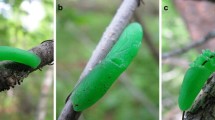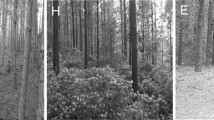Abstract
Numerous studies conducted in agro-ecosystems support the enemies hypothesis, which states that predators and parasites are more efficient in controlling pest densities in polycultures than in monocultures. Few similar studies, however, have been conducted in forest ecosystems, and we do not yet have evidence as to whether the enemies hypothesis holds true in forests. In a 2-year study, we investigated whether the survival of autumnal moth (Epirrita autumnata) larvae and pupae differs between silver birch monocultures and two-species mixtures of birch with black alder, Norway spruce and Scots pine. We placed young larvae on birch saplings and monitored their survival until the end of the larval period, when we checked whether they had been parasitized. After the larvae had pupated, pupal survival was tested in a field trial. In 2002, the larvae disappeared earlier and their overall survival was lower in birch–pine mixtures than in other stand types. In 2003, survival probability was lowest in birch–pine stands only during the first week and there were no differences between stands in overall survival. Larval parasitism was not affected by tree species composition. Pupal weight and pupal survival were likewise not affected by stand type. Among the predators, wood ants were more abundant on birches growing in birch–pine mixtures than in other stand types probably because colonies of myrmecophilic aphids were common on pines. In contrast, spider numbers did not differ between stand types. Ant exclusion by means of a glue ring around the birch trunk increased larval survival, indicating that ants are important predators of the autumnal moth larvae; differences in larval survival between stands are probably due to differential ant predation. Our results provide only partial support for the enemies hypothesis, and suggest that it is both tree species composition and species diversity which affect herbivore survival and predation.




Similar content being viewed by others
References
Allison PD (1995) Survival analysis using the SASsystem: a practical guide. SAS Institute, Cary
Anderson DR, Burnham KP, Thompson WL (2000) Null hypothesis testing: Problems, prevalence, and an alternative. J Wildl Manage 64:912–923
Andow DA (1991) Vegetational diversity and arthropod population response. Annu Rev Entomol 36:561–586
Bylund H (1995) Long-term interactions between the autumnal moth and mountain birch: the roles of resources, competitors, natural enemies and weather. PhD thesis, Swedish University of Agricultural Sciences
Cappuccino N, Lavertu D, Bergeron Y, Règnière J (1998) Spruce budworm impact, abundance and parasitism rate in a patchy landscape. Oecologia 114:236–242
Casas J, Aluja M (1997) The geometry of search movements of insects in plant canopies. Behav Ecol 8:37–45
Coll M, Bottrell DG (1994) Effects of nonhost plants on an insect herbivore in diverse habitats. Ecology 75:723–731
Cox DR (1972) Regression models and life tables. J R Stat Soc B 34:187–220
Elton CS (1958) The ecology of invasions by animals and plants. Methuen, London
Faeth SH, Hammon KE (1997) Fungal endophytes in oak trees: long-term patterns of abundance and associations with leafminers. Ecology 78:810–819
Frank JH (1967) The insect predators of the pupal stage of the winter moth, Operophtera brumata (L.) (Lepidoptera: Hydriomenidae). J Anim Ecol 36:375–389
Gingras D, Dutilleul P, Boivin G (2002) Modeling the impact of plant structure on host-finding behavior of parasitoids. Oecologia 130:396–402
Haukioja E, Neuvonen S, Hanhimäki S, Niemelä P (1988) The autumnal moth in Fennoscandia. In: Berryman AA (ed) Dynamics of forest insect populations. Patterns, causes, and implications. Plenum, New York, pp 163–178
Hooper DU, Vitousek PM (1997) The effects of plant composition and diversity on ecosystem processes. Science 277:1302–1305
Horgan FG, Myers JH, Van Meel R (1999) Cyzenis albicans (Diptera: Tachinidae) does not prevent the outbreak of winter moth (Lepidoptera: Geometridae) in birch stands and blueberry plots on the lower mainland of British Columbia. Environ Entomol 28:96–107
Ito F, Higashi S (1991) An indirect mutualism between oaks and wood ants via aphids. J Anim Ecol 60:463–470
Jactel H, Brockerhoff E, Duelli P (2004) A test of the biodiversity-stability theory: meta-analysis of tree species diversity effects on insect pest infestations, and re-examination of responsible factors. In: Scherer-Lorenzen M, Körner C, Schulze E-D (eds) The functional significance of forest diversity. Springer, Berlin Heidelberg New York (in press)
Kaitaniemi P, Ruohomäki K (2001) Sources of variability in plant resistance against insects: free caterpillars show strongest effects. Oikos 98:461–470
Karhu K (1998) Effects of ant exclusion during outbreaks of a defoliator and a sap-sucker on birch. Ecol Entomol 23:185–194
Kemp WP, Simmons GA (1978) Influence of stand factors on parasitism of spruce budworm eggs by Trichogramma-Minutum. Environ Entomol 7:685–688
Kemp WP, Simmons GA (1979) Influence of stand factors on survival of early instar spruce budworm (Choristoneura fumiferana). Environ Entomol 8:993–996
Koricheva J, Mulder CPH, Schmid B, Joshi J, Huss-Danell K (2000) Numerical responses of different trophic groups of invertebrates to manipulations of plant diversity in grasslands. Oecologia 125:271–282
Mahdi T, Whittaker JB (1993) Do birch trees (Betula pendula) grow better if foraged by wood ants. J Anim Ecol 62:101–116
McNett BJ, Rypstra AL (2000) Habitat selection in a large orb-weaving spider: vegetational complexity determines site selection and distribution. Ecol Entomol 25:423–432
Mikola J, Salonen V, Setälä H (2002) Studying the effects of plant species richness on ecosystem functioning: does the choice of experimental design matter? Oecologia 133:594–598
Moran VC, Southwood TRE (1982) The guild composition of arthropod communities in trees. J Anim Ecol 51:289–306
Pearce JL, Venier LA, McKee J, Pedlar J, McKenney D (2003) Influence of habitat and microhabitat on carabid (Coleoptera: Carabidae) assemblages in four stand types. Can Entomol 135:337–357
Peterson NA, Nilssen AC (1996) Nonlinear temperature-dependent development of autumnal moth pupae, Epirrita autumnata (Lepidoptera: Geometridae). Environ Entomol 25:147–154
Pimentel D (1961) Species diversity and insect population outbreaks. Annu Entomol Soc Am 54:76–86
Punttila P, Haila Y, Pajunen T, Tukia H (1991) Colonization of clear-cut forests by ants in the southern Finnish taiga—a quantitative survey. Oikos 61:250–262
Punttila P, Haila Y, Niemelä J, Pajunen T (1994) Ant communities in fragments of old-growth taiga and managed surroundings. Ann Zool Fenn 31:131–144
Raymond B, Vanbergen A, Watt A, Hartley SE, Cory JS, Hails RS (2002) Escape from pupal predation as a potential cause of outbreaks of the winter moth, Operophtera brumata. Oikos 98:219–228
Root RB (1973) Organization of a plant-arthropod association in simple and diverse habitats: the fauna of collards (Brassica oleracea). Ecol Monogr 43:95–124
Rosengren R, Vepsäläinen K, Wuorenrinne H (1979) Distribution, nest densities, and ecological significance of wood ants (the Formica rufa -group) in Finland. O.I.L.B. Bull SROP II 3:181–213
Ruohomäki K, Virtanen T, Kaitaniemi P, Tammaru T (1997) Old mountain birches at high altitudes are prone to outbreaks of Epirrita autumnata (Lepidoptera: Geometridae). Environ Entomol 26:1096–1104
Ruohomäki K, Tanhuanpää M, Ayres MP, Kaitaniemi P, Tammaru T, Haukioja E (2000) Causes of cyclicity of Epirrita autumnata (Lepidoptera: Geometridae): grandiose theory and tedious practice. Popul Ecol 42:211–223
Russell EP (1989) Enemies hypothesis: a review of the effect of vegetational diversity on predatory insects and parasitoids. Environ Entomol 18:590–599
Saalas U (1949) Suomen metsähyönteiset. Werner Söderström oy, Helsinki
Saetre P, Brandtberg PO, Lundkvist H, Bengtsson J (1999) Soil organisms and carbon, nitrogen and phosphorus mineralisation in Norway spruce and mixed Norway spruce—Birch stands. Biol Fertil Soils 28:382–388
SAS (1999) SAS/STAT user’s guide, Version 8. SAS, Cary
Sheehan W (1986) Response by specialist and generalist natural enemies to agroecosystem diversification—a selective review. Environ Entomol 15:456–461
Skinner GJ, Whittaker JB (1981) An experimental investigation of inter-relationships between the wood-ant (Formica rufa) and some tree-canopy herbivores. J Anim Ecol 50:313–326
Speight MR, Wainhouse D (1989) Ecology and management of forest insects. Oxford University Press, Oxford
Su Q, MacLean DA, Needham TD (1996) The influence of hardwood content on balsam fir defoliation by spruce budworm. Can J For Res 26:1620–1628
Tammaru T (1998) Determination of adult size in a folivorous moth: constraints at instar level? Ecol Entomol 23:80–89
Tammaru T, Kaitaniemi P, Ruohomäki K (1995) Oviposition choices of Epirrita autumnata (Lepidoptera: Geometridae) in relation to its eruptive population dynamics. Oikos 74:296–304
Tanhuanpää M, Ruohomäki K, Kaitaniemi P, Klemola T (1999) Different impact of pupal predation on populations of Epirrita autumnata (Lepidoptera: Geometridae) within and outside the outbreak range. J Anim Ecol 68:562–570
Tanhuanpää M, Ruohomäki K, Uusipaikka E (2001) High larval predation rate in non-outbreaking populations of a geometrid moth. Ecology 82:281–289
Teder T, Tanhuanpää M, Ruohomäki K, Kaitaniemi P, Henriksson J (2000) Temporal and spatial variation of larval parasitism in non-outbreaking populations of a folivorous moth. Oecologia 123:516–524
Tenow O (1972) The outbreaks of Oporinia autumnata Bkh. and Operophtera spp. (Lep. Geometridae) in the Scandinavian mountain chain and northern Finland 1862–1968. Zool Bidr Uppsala 2:1–107
Wardle DA, Bonner KI, Nicholson KS (1997) Biodiversity and plant litter: experimental evidence which does not support the view that enhanced species richness improves ecosystem function. Oikos 79:247–258
Acknowledgements
We thank Tommi Korhonen and Katja Sippola for assistance in the field and in the lab, and Ira Alatalo, Lauri Kapari and Tapio Van Ooik for supplying us with Epirrita eggs. We are grateful to Kai Ruohomäki and to two referees for comments on the manuscript and to Tommi Andersson and Miia Käär for the advice on rearing larvae. The Satakunta Environmental Research Institute provided us with working facilities. Ellen Valle kindly checked the language. This study was financed by the Academy of Finland (project 76735).
Author information
Authors and Affiliations
Corresponding author
Rights and permissions
About this article
Cite this article
Riihimäki, J., Kaitaniemi, P., Koricheva, J. et al. Testing the enemies hypothesis in forest stands: the important role of tree species composition. Oecologia 142, 90–97 (2005). https://doi.org/10.1007/s00442-004-1696-y
Received:
Accepted:
Published:
Issue Date:
DOI: https://doi.org/10.1007/s00442-004-1696-y




